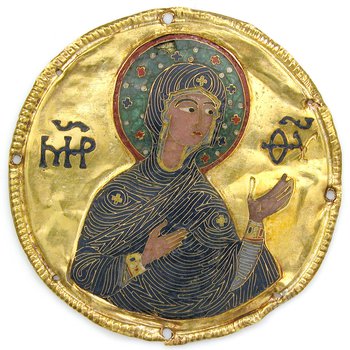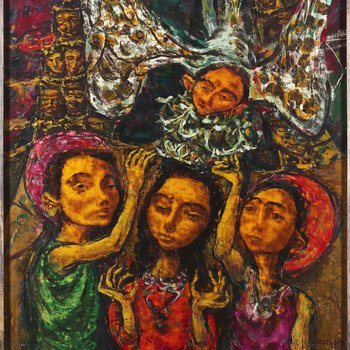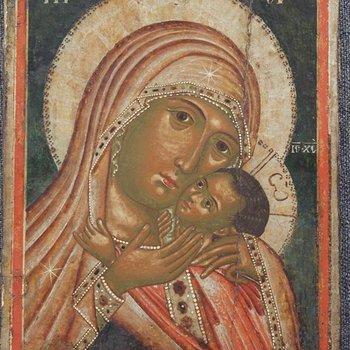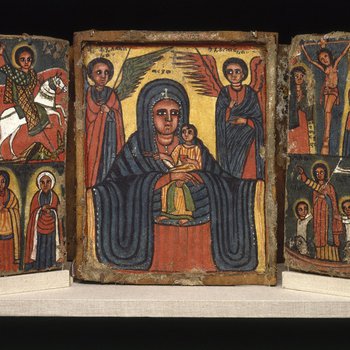Mary (Daughter of Anne)
Mary is often identified by both her role as a mother and her sexual status as a “virgin” in the Christian narrative. She is referred to as the Virgin Mary, the Mother of Jesus, the wife of Joseph, and Our Lady of Guadalupe, to name a few. Yet, it is important to remember that first and foremost, she was the daughter of Anne (Catholic Encyclopedia, 2003). Mary serves as an integral component of the Christian emergence accounts since the story of Jesus begins with her and even into modern times she continues to serve as a divine icon or image worshiped by Christians (Hopfe & Woodward, 2012; Young, 2013).
In this narrative, Mary became the first Christian disciple through motherhood. Scripture places an emphasis on her sexual status as a “virgin mother” to exemplify her faithful acceptance of divine intervention –– or divine annunciation –– in converting her young chaste womb to that of a pregnant one (Luke 1:26-38, 46:55; Matthew 1:18-25; Qur’an 3:367, 14:1321). Reflecting Jewish domestic expectations set centuries earlier by Sarai, Mary’s role of mother and spouse recounts little of her family history as a person in her own right (Rubin, 2009), outside of connecting her ancestry to Sarai and Abraham (Yazdi & Ali, 1995). Unfortunately, Scripture also only sparingly mentions her role as mother and caregiver (Luke 2:44-48), her faith in her son’s ministry (Luke 2:34-35), and her presence at Jesus’s death (John 19:25-26). Mary’s intermittent insertions throughout the life of her son forces the bulk of her account in Christianity to rest on her virgin sexual status since this legitimized the divinity of Jesus in human form. In the Catholic tradition, Mary’s own immaculate conception through her mother, Anne, was added centuries after Mary’s life to further solidify this divine connection (New Catholic Encyclopedia, 2003).
Nevertheless, Mary is an integral symbolic component of Christianity both on a local and global scale. When she accepted the responsibility of a divine being born of only her flesh (Galatian 4:4; McNamara, 1996; Rubin 2009), Mary became the first convert to this new religion, later called Christianity. Her actions supporting Christianity, as recalled in the brief patches of scripture depicting Mary’s persona, created the foundation for the religion itself and has swelled over the centuries to embody Mary herself as a demi-goddess (Anderson & Zinsser, 1998). Through the spread of Catholicism and missionary work, she became a feminine icon, one whom believers could identify with, and this symbolism aided in religious conversions around the world. Throughout history she has served as a representative of motherhood, purity, victory, consolation, and protection, as well as a female intercessor to whom mortal women could relate to (Anderson & Zinsser, 1998; McNamara, 1996; Rubin, 2009; Young, 1993; Wiesner-Hanks, 2010).
Works Cited
Anderson, B.S. & Zinsser, J.P. (1988). A History of Their Own: Women in Europe from Prehistory to the Present. (Vol.1). New York, NY: Harper and Row.
McNamara, J. A. (1996). Sisters in Arms: Catholic Nuns through Two Millennia. Cambridge,
MA: Harvard University Press.
Rubin, M. (2009). Mother of God: A History of the Virgin Mary. New Haven, CT: Yale University Press.
Wiesner-Hanks, M.E. (2010). Christianity and Sexuality in the Early Modern World: Regulating Desire, Reforming Practice (2nd ed.). New York, NY: Routledge.
Yazdi, A., & Ali, S. (1995). Introduction. The Holy Qur'an (A. Yazdi, S Ali Trans.). (2nd ed.,
pp. 7a-173a). Elmhurst, NY: Tahrike Tarsile Qur'an, Inc.
Young, S. (Ed.). (1993). An Anthology of Sacred Texts by and about Women. New York, NY:
The Crossroad Publishing Company.





